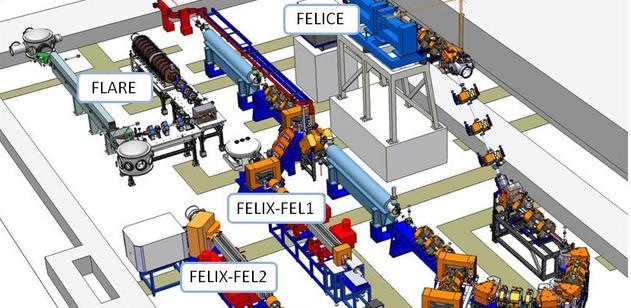FELIX
The FELIX (Free Electron Lasers for Infrared eXperiments) facility in Nijmegen is an international user facility providing the scientific community with tunable radiation of high brightness in the mid- and far-infrared as well as the THz regime.
The facility houses two independent accelerators that together drive four FELs: FELIX-1, FELIX-2, FELICE and FLARE. The total spectral range covered extends from 3 to1500 µm. The temporal and transverse beam profiles are close to transform, respectively diffraction limited.
The primary applications are found in areas benefitting either from the high brightness or the high fluence of the light sources. In 12 experimental stations, advanced auxiliary equipment such as FTICR mass spectrometers, molecular beam machines and four-wave-mixing setups are available to the users. Worldwide unique stations are those connected to FELICE for intra-cavity experiments as well as to the high field magnet laboratory (HFML), the latter enabling experiments in quasi-continuous fields up to currently 35 T.
Current status:
FLARE has provided first light in September 2011 but is not yet fully commissioned. First user experiments, including experiments in the HFML, have started recently.
FELIX and FELICE: have been relocated from the FOM Institute Rijnhuizen to the Radboud University Nijmegen and first lasing at the new location has been achieved in July 2013. Since October 2013, user operation is gradually being resumed.
|
Beam parameters |
Value |
|---|---|
|
Spectral range [cm-1] |
6.6 - 3500 cm (0.2 - 100THz) |
|
Tunability [%] |
200 - 300 |
|
Pulse structure: Micropulse/ micropulse |
5µs, 10 Hz / 1000 or 25 MHz or single pulse |
|
Micropulse energy [µJ] |
0.5 - 30 |
|
Spectral width [%, rms] |
0.2 - several |
|
Micropulse duration |
Transform limited |
|
FEL mode |
TEM_00 |
|
Polarization |
Linear |

